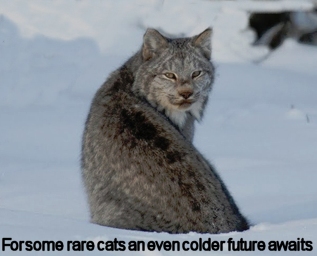Cryopreservation: an icy Ark for endangered cat species.

It's not good news for any species to appear on the Red List of the International Union for the Conservation of Nature (IUCN) - it means that the survival of this species is seriously in doubt. Sadly, many wild cats and in particular most small wild cats have made the list. The reason, of course, is the ever-expanding human population of the planet. Even where wild cats are not actively hunted or exterminated as pests, the cats are threatened with extinction by the disappearance of their native habitat. No-one expects the situation to improve in the coming decades, and by the time a solution is found - assuming one is - it is almost certain that some species will have died out in the meantime.
Therefore conservationists are turning to science for desperate last measures to prevent some cat species from vanishing from the planet forever. Even if the cats themselves cannot be saved, perhaps enough of them can be kept for the species to be reintroduced at a later date. At least this is the hope of scientists from the Leibniz Institute for Zoo and Wildlife Research (IZW) who have started a program for the cryopreservation of ovarian cortexes from different wild cats.
Cyropreservation is the science of preserving bodies, or parts of bodies, at low temperature so that the material does not decay and can be reused once successfully thawed out. The ovary is the part of the female body responsible for producing eggs, and the the outer part of an ovary is called the cortex (the inner part is called the 'medulla', by the way).
The important thing about the ovarian cortex is that it contains thousands of immature oocytes - cells with a key role in the reproductive process. The advantage of immature oocytes is that they tolerate storage in liquid nitrogen, and these intensely cold levels (minus 196 degrees Celsius) allow preservation indefinitely. Therefore preserving these oocytes in the cortex means preserving the fertility of the ovary, and the science for this is well-established.
For a number of years now, doctors have been able to remove the ovarian cortex from human cancer patients prior to treatment by chemotherapy that would damage the ovaries beyond repair. In some cases, where the chemotherapy has been successful, scientists have been able to restore the ovarian cortex in the laboratory, re-transplant it into the patient and restore that patient's fertility.
However, the project for preserving feline ovarian cortexes breaks new ground in several fields. Preserving human ovarian cortexes is a tricky job, because the scientists have to preserve more than individual cells. The essential immature oocytes are surrounded by connective tissue and blood vessels and this complex organism of interconnected cells needs careful treatment because each type of cell handles cyropreservation differently. With wild cats the problem moves to a higher degree of complexity again, because the ovarian cortex of each species is slightly different, so the treatment has to be adapted on a case-by-case basis.
However, the scientists from the Liebniz Institute believe that they have resolved the knotty issues behind freezing and restoring feline ovarian tissue, and have shown in laboratory tests that they can restore viable material for fourteen days after freezing and defrosting. For those with an interest in the science and detailed methodology underlying their technique, a full academic description can be found online.
As a result of its research the Leibniz Institute is in a position to offer a chance for cats that otherwise face almost certain extinction. The Institute claims, justifiably, that its tissue bank is crucial to preserve the genetic diversity of wild cat species.
The branch of the institute dedicated to such work is the Leibnitz Institute for Zoo and Wildlife Research, usually abbreviated to IZW.(The home page of the IZW website can be found here. (http://www.izw-berlin.de/welcome.html). An important part of the IZW is a genome resource bank called 'Arche' ('Ark' in German). This 'Ark' already contains a variety of sperm samples from endangered species. Now the preservation of ovarian cortexes means that the female counterpart to these sperm cells can also be preserved, making the later re-establishment of a vanished species a practical proposition.
As of 2007 the 'Felid Gamestes Rescue Project' has concentrated on storing material from different cat species. The IZW has been building up a stock of feline cells from Europe which have been made available to breeding projects in zoos across the continent. Many zoos are now active participants. The IZW hopes that their Ark will continue to grow and add feline species, not exactly two-by-two but by sperm and ovarian cortex until every endangered feline species has at least a chance of recovery at some future date.
Journal Reference:
Caterina Wiedemann, Jennifer Zahmel, Katarina Jewgenow. Short-term culture of ovarian cortex pieces to assess the cryopreservation outcome in wild felids for genome conservation. BMC Veterinary Research (2013); 9(1) pp37 (the full article can be downloaded from here)

